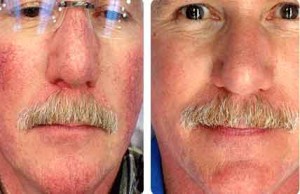 Visible facial veins — spider veins, telangiectasias, spider angiomas, and benign vascular lesions — are actually dilated blood vessels. They dilate because of weakening elastic fibers in the vascular walls. Visible veins are associated with excessive sun exposure, normal aging, rosacea, steroid use, pregnancy, oral contraceptives, liver disease, genetics, radiation therapy, and trauma. They’re usually found on the forehead, nose, cheeks, eyelids, neck, and upper chest. On the face, visible veins range in size from the tip of a pencil lead to bigger than a pencil eraser. Elsewhere on the body they can grow even larger.
Visible facial veins — spider veins, telangiectasias, spider angiomas, and benign vascular lesions — are actually dilated blood vessels. They dilate because of weakening elastic fibers in the vascular walls. Visible veins are associated with excessive sun exposure, normal aging, rosacea, steroid use, pregnancy, oral contraceptives, liver disease, genetics, radiation therapy, and trauma. They’re usually found on the forehead, nose, cheeks, eyelids, neck, and upper chest. On the face, visible veins range in size from the tip of a pencil lead to bigger than a pencil eraser. Elsewhere on the body they can grow even larger.
Spider Veins/Broken Capillaries
There are tiny and delicate veins just under the skin that are responsible for the blood circulation in the face. When the walls of these veins narrow and widen suddenly, breakage may occur. They are commonly known as spider veins because of their tree-branch or spider-web appearance. Spider veins can be found around the nose, cheeks and mouth, on the neck, as well as the upper chest and legs. Broken capillaries close to the skin surface and can be identified by their red or blue color. Sometimes these kinds of ruptures can’t heal (disappear) without treatment.
Rosacea/Telangiectasia
Rosacea is a chronic, inflammatory skin condition that primarily affects the face and is characterized by facial erythema. Rosacea typically begins as redness on the central face across the cheeks, nose, or forehead, but can also less commonly affect the neck, chest, ears, and scalp and, at times, can produce small, red, pus-filled bumps. Left untreated, rosacea tends to worsen over time. Many people also develop small visible vessels on their faces as well, often called telangiectasia. Telangiectases are widened venules (tiny blood vessels) that cause red lines or patterns on the skin.
What evolé Mediclinic Can Do…
We use a precise hand piece that targets each blood vessel with Broad Band Light (BBL™) applied in a series of gentle pulses. Without damaging the outer layer of skin, the light penetrates through the skin and breaks up the ruptured blood vessel or lesion. The result is then reabsorbed by the body as part of the natural healing process. Please check the following for details:
Call (360) 647‑6991 or use the website Contact Form.